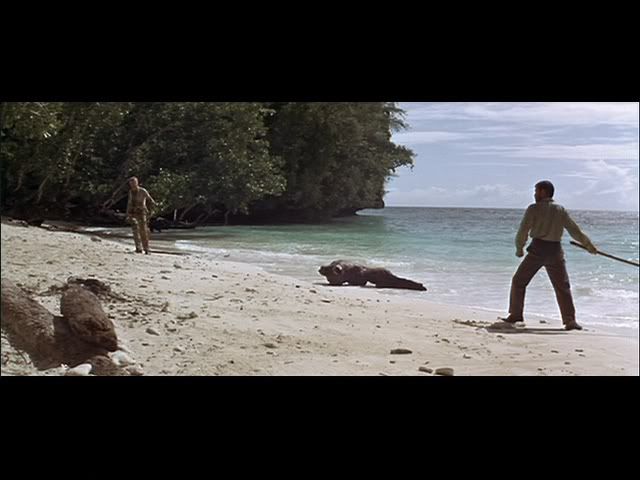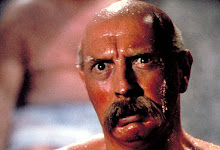
Originally run on 10 November 2008 for my column "Cinecult.
Deep down in the heart of every urbane, liberal, too hip for westerns or war movies is a simple man who loves survival films. Everyone loves watching them, which would explain why zombie flicks have had such a renaissance as of late or why Survivor, after forty-million seasons, is still one of the biggest game shows on TV or why each of us is willing to shell out ten dollars to see Tom Hanks talk to a volleyball. We love survival stories and Hell in the Pacific is one of those great tales.
Hell in the Pacific takes place during WWII and centers around a shipwrecked American airman who washes up on a deserted island only to find that the island is already occupied by another stranded soldier—a Japanese one. Though, the main draw of the film isn’t the two men trying to survive or their clever plans to beat each other, the real reason to check it out is for Lee Marvin, (The Dirty Dozen, The Man Who Shot Liberty Valance), Toshiro Mifune (The Seven Samurai, Grand Prix), and their respective beards.
Marvin is definitely one of the great faces in acting. He could tell you more about his character with one look from his grey, dog-tired face than most actors probably have in their entire oeuvre. Everything about the man is 100%, grade-A badass. If there ever were a man you wouldn’t want to fight a war against, it’d be him. Then, of course, there’s his rival, Mifune, who is always a delight. He’s a strong enough presence to convey what he’s saying despite his total lack of subtitling.
Hell in the Pacific is a rather brave movie in a few ways. It’s certainly entertaining to watch, but it’s a long way away from the spectacle that accompanies most other war films. Rather than the standard set pieces, their encounters resemble school boys bickering rather than a full-blown, drag-out fight. Though this isn’t a regular action movie, it’s a drama about two great actors—two of the manliest men ever to grace the screen—combating each other not for valor or country, but for a sack full of fresh water.
I’ve heard about movies starting without a finished script (Apocalypse Now, for example, went into production without one), but I don’t think I’ve ever heard of a film finishing without a finalized script. In this film, the whole narrative concludes suddenly with no reasoning as to why or how it ends. It would be like at the end of Star Wars, if some rebel walked in and said, “Oh yeah, the Death Star thing? It got blown up.” The End. Roll credits. It’s a black mark on an otherwise engrossing movie.
Beyond the questionable ending, Hell in the Pacific is a simple, but gripping drama. There’s no big fight scene, only a battle of wits and of attrition over a jungle-infested rock. From the acting to the score to the cinematography, it still delivers a solid, enjoyable experience and serves as an example of how a film can do so much with so little.

No comments:
Post a Comment